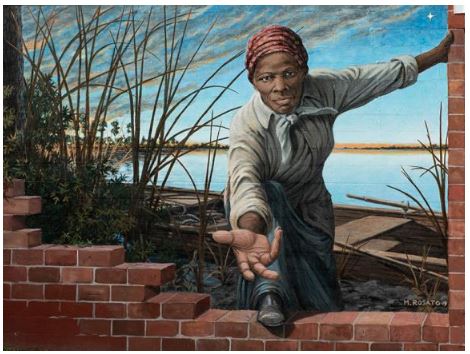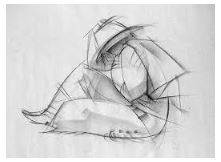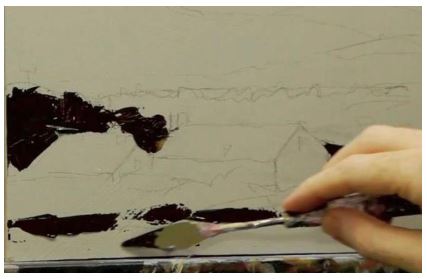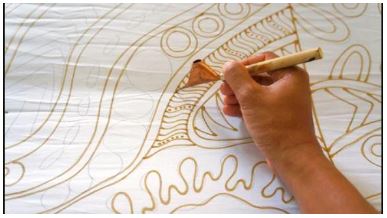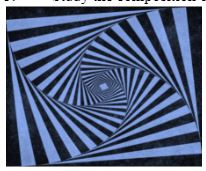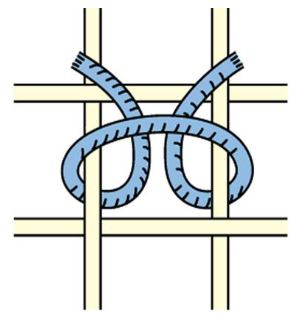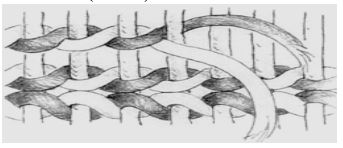- This paper consists of three sections A, B and C.
- Answer all questions in section A and B.
- Answer any one question in section C
- Where drawings and diagrams are appropriate, they should be included within the text of your answers
SECTION A (20 MKS)
Answer all questions in this section in the spaces provided
-
- Study the artwork below.
State the type of painting portrayed and identify an appropriate title for the artwork. (2mks) - Offset lithography is one of the techniques of printmaking. Describe the process. (2mks)
- Study the artwork below.
Making refence to the artwork, distinguish between form and shape as elements of Art and Design. (2mks) - Give two advantages of using charcoal as a drawing tool. (2mks)
- The picture below shows a stage in painting an artwork.
Describe the technique portrayed. (2mks) - Outline two functions of a loom as a tool used in weaving. (2mks)
- State the main reason for sizing the support surface before painting. (2mks)
- State two characteristics of a mosaic artwork. (2mks)
- Define a design brief as used in graphic design.(2mks)
- Name any two accessories used to fasten jewellery which is worn.(2mks)
- Study the artwork below.
SECTION B (25 MARKS)
Answer all the questions in this section in the spaces provided.
-
- Distinguish between applied and structured designs of fabric decoration.(2mks)
- The picture below shows a process in batik technique. Describe the process. (3mks)
- Outline 5 factors to consider in sculpture placement. (5mks)
- Read the following statement and rewrite it in calligraphic lettering in the box below.
“Dream what you want to dream, go where you want to go, be what you want to be. Because you have only one life and one chance to do all you want to do.” (5mks) -
- Describe the following process in pottery. (2mks)
- Give two roles of slip in Pottery.
- Explain one factor to consider when creating poterry with the handbuilding technique above( 2mks)
- Study the composition below and answer the questions that follow
- State the most outstanding principle (2mark)
- Describe three ways in which the above named principle has been achieved in composition. (3marks)
SECTION C
-
- State the two main precautions to be taken when curving out a block for printing. (2marks)
- Explain how half tones are achieved in gravure printing. (3marks)
- Explain the process of printing a two colored motif using the screen. (10marks)
-
- Outline the four main stages of the weaving process (4 marks)
- State any two ways of finishing a woven fabric. (2 marks)
- Illustrate the following weave structures.
- Ghiordes knot (5 marks)
- Twining weave (4 marks)
- State the two distinguishing characteristics of a mosaic. (2marks)
- Explain how solidity is achieved in 2D mosaic works (3marks)
- Briefly explain the process of making a picture using mosaic technique witheach of the following materials
- Glass/stones (5marks)
- Banana fibers/ paper/ egg shells (5marks)
MARKING SCHEME
SECTION A (20 MKS)
Answer all questions in this section in the spaces provided
-
- Study the artwork below.
State the type of painting portrayed and identify an appropriate title for the artwork. (2mks)- Type is Mural
- Title: (any appropriate)
- Offset lithography is one of the techniques of printmaking. Describe the process. (2mks)
- Offset printing is a common printing technique in which the inked image is transferred (or "offset") from a plate to a rubber blanket and then to the printing surface. When used in combination with the lithographic process, which is based on the repulsion of oil and water, the offset technique employs a flat (planographic) image carrier. Ink rollers transfer ink to the image areas of the image carrier, while a water roller applies a water-based film to the non-image areas.
- Study the artwork below.
Making refence to the artwork, distinguish between form and shape as elements of Art and Design. (2mks)- Form is 3D while shape is 2D…shapes of the head and legs and hands have been given depth by the use of value to create the form of a human being. Form has complex structures while shapes are simple like circles and triangles and in the image, simple shapes have added lines like the hat on head to make it conical giving it the form of a hat
- Give two advantages of using charcoal as a drawing tool. (2mks)
- It's an ancient drawing material, used for thousands of years
- It's a natural material, safe for our health and environment
- It's really inexpensive
- It's a great medium to learn to work with tonal values.
- It's very versatile: many different techniques and 'looks' possible.
- The picture below shows a stage in painting an artwork.
Describe the technique portrayed. (2mks)- Pallete knife painting technique where paint is scooped by use of a pallet knife to create textural effects on a canvas.
- Outline two functions of a loom as a tool used in weaving. (2mks)
- Hold warp threads at tension to enable weft threads to be passed across
- Helps make the weave firm
- Helps determine length of weave
- State the main reason for sizing the support surface before painting. (2mks)
- Stabilize surface to reduce absorbency while protecting fibres from deteriorating
- State two characteristics of a mosaic artwork. (2mks)
- Crackle or shimmering effect
- Monomedia
- Juxtaposition of tesserae
- Looks 2 dimensional
- What is a design brief.(2mks)
- Client specifications from client to designer stating the design problem, possible solutions, timelines and budget.
- Name any two accessories used to fasten jewellery which is worn. (2mks)
- Clips
- Hooks
- Clasps
- Study the artwork below.
SECTION B (25 MARKS)
Answer all the questions in this section in the spaces provided.
-
- Distinguish between applied and structured designs of fabric decoration.(2mks)
- Applied design is created and placed or printed on top of a fabric while structured design is woven with the fabric during production
- The picture below shows a process in batik technique. Describe the process. (3mks)
- A design is first created then color separation is done. (1 mk)The design is then transfered onto the fabric lightly with a pencil. (1 mk) The wax is melted and poured into a tjantin which is used to pour wax onto the non image areas (1 mk)
- Distinguish between applied and structured designs of fabric decoration.(2mks)
- Outline 5 factors to consider in sculpture placement. (5mks)
- Material of the sculpture
- Location wheteher indoors or outdoors
- Size of the sculpture
- Message of the sculpture/Function
- Intended audience of the sculpture
- Background/display area
- Read the following statement and rewrite it in calligraphic lettering in the box below.
“Dream what you want to dream, go where you want to go, be what you want to be. Because you have only one life and one chance to do all you want to do.” (5mks) -
- Describe the following process in pottery.(2mks)
- Coiling technique
- Give two roles of slip in Pottery.
- Join two pieces together
- Smoothen
- Decorate in slip trailing technique
- Explain one factor to consider when creating poterry with the handbuilding technique above( 2mks)
- Length of coils as they differ with size and shape of article being built
- Describe the following process in pottery.(2mks)
- Study the composition below and answer the questions that follow
- State the most outstanding principle (2mark)
- Rythym and movement
- Describe three ways in which the above named principle has been achieved in composition. (3marks)
- Repetiton of Lines
- Alternation of light and dark lines
- Gradual progression of the lines towards the centre or from the centre
- State the most outstanding principle (2mark)
SECTION C
Answer only ONE question in the spaces provied after the paper.
-
- State the two main precautions to be taken when curving out a block for printing. (2marks)
- Always plan on paper how the motif will appear when finally printed.
- Images and words to be curved on the block should be done in reverse so as to achieve a correct view when printed, e.g the word BABY should be curved in reverse to read BABY on the printing block so as to read BABY after print.
- The block used should be thick enough to allow higher protrusion of the images or letters so as to avoid smudging of ink on the negative areas.
- Sunken areas should be deep enough so as not to pick ink when spreading with a brayer/roller.
- Explain how half tones are achieved in gravure printing. (3marks)
- This involves sinking in the image areas using a metallic tool called a rocker
- The rocker tool roughens the printing plate with thousands of small dots.
- The dots can be worked in a way that half-tones are achieved during the printing process by concentrating the dots on the side that has half lights and spersly distributing dots on the side that has highlights therefore creating shades in a printed work thus creating effects of depth or volume.
- Explain the process of printing a two colored motif using the screen. (10marks)
- Sketch the design to be printed giving color to it
- A single screen or two screens can be used.
Single screen method- If a single screen is used, transfer portions allocated to the first color ONLY onto the screen and block out to get the first color stencils
- Print with the first color
- Wash the screen and dry it
- Transfer portions of the second color onto the screen and block the screen out to create stencils that will allow passage of the second color.
- Some areas of the second color may overlap with first color to create a third color.
Two screens - If more than one screen is to be used, register the two screens to be used.
- Transfer portions of the first color on one screen and block the non-image areas to create stencils for passage of ink.
- Transfer portions of the second color on one screen and block the non-image areas to create stencils for passage of ink.
- Register the working surface to ensure accurate placement of the screens
- Print with first color through the design and leave the work to dry completely.
- Using the second screen, print with the second color.
- State the two main precautions to be taken when curving out a block for printing. (2marks)
-
- Outline the four main stages of the weaving process (4 marks)
- Warping the loom
- Shedding
- Picking
- Beating down
- State any two ways of finishing a woven fabric. (2 marks)
- Braiding the end warps
- Twisting the end waps
- Cutting off the warps and bindingthe loose edge with a piece of cloth
- Illustrate the following weave structures.
- Ghiordes knot (5 marks)
- Twining weave (4 marks)
- Ghiordes knot (5 marks)
- Outline the four main stages of the weaving process (4 marks)
-
- State the two distinguishing characteristics of a mosaic. (2marks)
- They are made of tesserae whose arrangement is not predetermined.
- They exhibit a network of spaces called interstices (crevice) which give mosaic its beauty
- Explain how solidity is achieved in 2D mosaic works (3marks)
- Toning is achieved by grouping the tesserae of different shades and arranging them over the image area in terms of value progression from the lightest to the darkest depending on the direction of source of light.
- Briefly explain the process of making a picture using mosaic technique witheach of the following materials
- Glass/stones (5marks)
- Prepare a wooden frame, 2cm (depth) and cover the base with plywood.
- Sketch the composition on paper and define the colour scheme
- Cut coloured glass or bleak stones using glass cutter or hammer to required size.
- Prepare cement / plaster of Paris and pour into the wooden frame
- Embed glass or stone tesserae in cement / plaster according to overall composition.
- Splash water on the cement to prevent rapid drying and to cure it-hand.
- After drying dismantle the frame (mould) and mount it for the purpose intended.
- Banana fibers/ paper/ egg shells (5marks)
- Sketch the composition and come up with a colour scheme.
- Cut the materials are group them according to different tones of the sketch colour scheme.
- Prepare a stiff ground e.g. strawboard prime the support, give it any colour you like for effective shimmering. It tones / colour of tessarae is dark, use a lighter background and vice versa.
- Transfer the sketch onto the working surface.
- Paste the tessarae unto the surface guided by the colour scheme of your composition.
- The work may be vanished with a thin layer of clear vanish.
- Frame the mosaic and hang it.
- Glass/stones (5marks)
- State the two distinguishing characteristics of a mosaic. (2marks)
Download Art and Design Paper 1 Questions and Answers - Lainaku 1 Joint PreMock Exams 2023.
Tap Here to Download for 50/-
Get on WhatsApp for 50/-
Why download?
- ✔ To read offline at any time.
- ✔ To Print at your convenience
- ✔ Share Easily with Friends / Students

